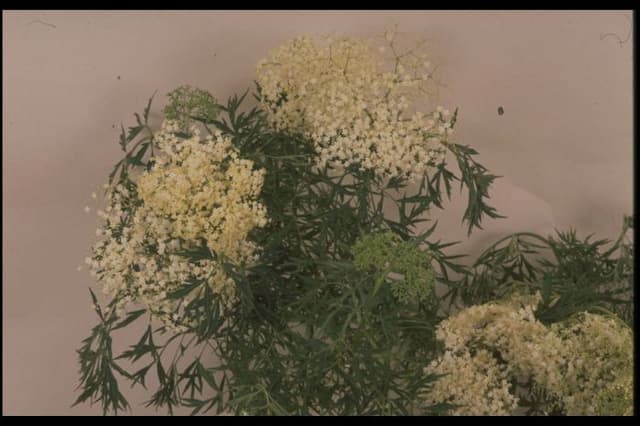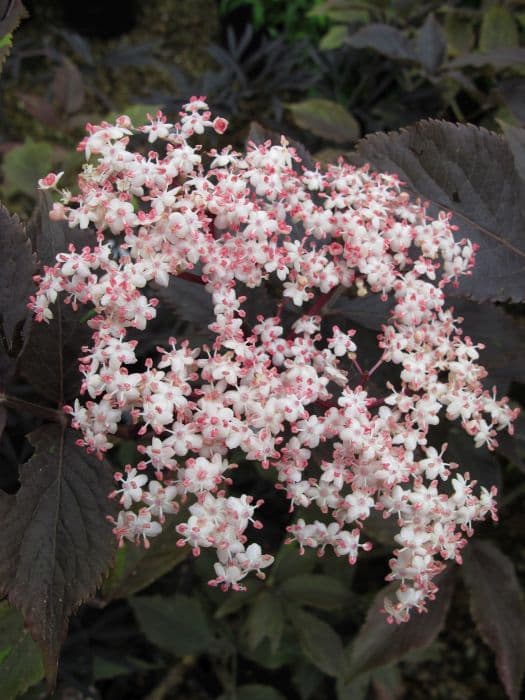Japanese Snowball Viburnum plicatum f. tomentosum 'Cascade'

ABOUT
The Doublefile Viburnum, named 'Cascade', is distinguished by its eye-catching floral display and layered branch structure. The plant possesses a horizontal branching habit that gives it a tiered appearance, much like the layers of a wedding cake. During the blooming season, which is typically in late spring, this deciduous shrub is adorned with showy, lacecap flowers. These flowers are composed of a ring of large, sterile florets that encircle a center of smaller, fertile flowers, creating a delicate, frothy effect. The blossoms are predominantly white, creating a striking contrast against the backdrop of the plant's deep green leaves. As the flowers wither, they often give way to small, red berry-like fruits that mature to a black color, attracting birds and other wildlife. The leaves themselves have an interesting texture; they are deeply veined, lending a pleated look that is complemented by a slightly fuzzy feel, hence the name "tomentosum" meaning "covered with hairs." In the fall, the foliage adds to the display by changing to a reddish-purple color, providing multi-season interest in the garden. The overall presentation of Doublefile Viburnum 'Cascade' is that of a graceful and layered shrub with a symmetrical and flat-topped appearance, cherished for its decorative blossoms and seasonal color changes.
About this plant
 Names
NamesFamily
Adoxaceae
Synonyms
Doublefile Viburnum, Japanese Snowball, Japanese Snowball Viburnum
Common names
Viburnum plicatum f. tomentosum 'Cascade'.
 Toxicity
ToxicityTo humans
Doublefile viburnum is generally considered non-toxic to humans. However, as with many plants, individual sensitivity can vary, and it is always advisable to avoid ingesting plant material that is not specifically meant for consumption. If large quantities of the plant are eaten, it may cause mild stomach upset, but severe poisoning is unlikely.
To pets
Doublefile viburnum is also generally recognized as non-toxic to pets. It is not known to cause any significant toxic effects when ingested by animals like dogs and cats. However, overconsumption of any plant material can potentially lead to gastrointestinal irritation or upset, so it's best to keep an eye on your pets and prevent them from eating large amounts of foliage or other plant parts.
 Characteristics
CharacteristicsLife cycle
Perennials
Foliage type
Deciduous
Color of leaves
Green
Flower color
White
Height
8 feet (2.4 meters)
Spread
10 feet (3 meters)
Plant type
Shrub
Hardiness zones
5
Native area
Japan China
Benefits
 General Benefits
General Benefits- Ornamental Appeal: 'Cascade' offers multi-season interest with its beautiful white lacecap flowers in spring, attractive foliage, and reddish-purple fall color.
- Wildlife Habitat: It provides food and shelter for birds and beneficial insects, enhancing biodiversity.
- Privacy Screen: The dense growing nature of 'Cascade' makes it suitable for use as a privacy screen or hedge.
- Low Maintenance: Once established, it requires minimal care, making it ideal for gardeners seeking a low-maintenance landscape addition.
- Drought Tolerance: It demonstrates a degree of drought resistance, reducing the need for frequent watering.
- Soil Adaptability: It can adapt to a wide range of soil conditions, making it versatile for various garden settings.
- Erosion Control: The shrub's root system helps to stabilize soil and prevent erosion on slopes.
 Medical Properties
Medical PropertiesThis plant is not used for medical purposes.
 Air-purifying Qualities
Air-purifying QualitiesThis plant is not specifically known for air purifying qualities.
 Other Uses
Other Uses- Photography Prop: The Doublefile Viburnum 'Cascade' can be used as a stunning backdrop for garden photography due to its symmetrically arranged floral displays.
- Nature-Inspired Art: Artists may use the intricate patterns of its branches and flowers as motifs in painting, drawing, or fabric design.
- Education: It can be included in horticulture curriculums to teach students about plant morphology and pruning techniques to maintain a layered appearance.
- Privacy Screening: When planted in a row or hedge, this variety provides visual screening without a manicured hedge look, thanks to its horizontal branching.
- Garden Bones: During winter, when leaves have fallen, the strong horizontal lines of Doublefile Viburnum 'Cascade' branches provide 'bones' to the garden landscape.
- Seasonal Decoration: In autumn, the leaves turn beautiful shades of red and burgundy, which can be used in seasonal decor both indoors and outdoors.
- Sound Barrier: Planting a thick hedge of these shrubs can help dampen noise from roads or neighbors due to its dense foliage.
- Birdwatching Attraction: The berries produced after flowering can attract birds, providing an opportunity for birdwatching enthusiasts.
- Weddings and Celebrations: Cut branches with flowers and leaves can be used in floral arrangements or as part of venue decor for special events.
- Erosion Control: The root system can help stabilize soil on slopes, making it useful in landscapes prone to erosion.
Interesting Facts
 Feng Shui
Feng ShuiDoublefile Viburnum is not used in Feng Shui practice.
 Zodiac Sign Compitability
Zodiac Sign CompitabilityDoublefile Viburnum is not used in astrology practice.
 Plant Symbolism
Plant Symbolism- Renewal: The 'Cascade' variety of viburnum, commonly known as Japanese Snowball, blooms in the spring, symbolizing new beginnings and the renewal that comes with this season.
- Purity: The pristine white flowers of the Japanese Snowball are often associated with purity and innocence.
- Abundance: With its lush, cascading blooms, it represents abundance and generosity.
- Perseverance: Viburnum are hardy plants that can endure various climates, symbolizing the ability to thrive through challenges.
- Beauty: The ornamental nature of the Japanese Snowball signifies beauty and the appreciation of aesthetic pleasures.
 Water
WaterThe Japanese Snowball, common name for Viburnum plicatum f. tomentosum 'Cascade', should be watered thoroughly, ensuring that the soil is moist but not soggy. During the first growing season, it’s crucial to establish a deep and extensive root system, which usually requires watering at least once a week unless there is steady rainfall. Apply about 1 to 1.5 gallons of water for each watering session. As the plant matures, watering frequency can decrease, and the plant will need a thorough watering every 2 to 3 weeks if there is no rain. Over-watering can cause root rot, so it's important to allow the soil to dry out slightly between waterings
 Light
LightJapanese Snowball thrives in full sun to partial shade. It performs best when planted in a location that receives at least four hours of direct sunlight daily but is also protected from the harsh afternoon sun to avoid leaf scorch. Dappled sunlight, such as that found under the canopy of open-branched trees, is also suitable for encouraging a robust bloom and healthy leaf growth.
 Temperature
TemperatureJapanese Snowball is a hardy shrub that can tolerate a range of temperatures. It can survive in temperatures as low as -20°F and as high as 100°F, though it thrives in a more moderate range between 60°F and 80°F. It is important to plant it in an area that avoids extreme temperature fluctuations, particularly in winter to prevent frost damage.
 Pruning
PruningPrune the Japanese Snowball immediately after it finishes blooming in late spring to early summer to shape the plant and remove any dead or diseased branches. This timing allows the shrub to form buds for the next year's flowers. Annual pruning helps to maintain an attractive shape and encourages vigorous growth. Sometimes, rejuvenation pruning may be necessary, which involves cutting back one-third to one-half of the oldest stems to ground level.
 Cleaning
CleaningAs needed
 Soil
SoilJapanese Snowball 'Cascade' thrives in well-draining soil rich in organic matter with a slightly acidic to neutral pH of 5.5 to 7.0. A mixture of garden soil, compost, and perlite or pine bark would create an ideal environment for healthy growth.
 Repotting
RepottingJapanese Snowball 'Cascade' planted in containers may require repotting every 2-3 years to provide fresh soil and accommodate root growth. In the landscape, it typically does not need repotting.
 Humidity & Misting
Humidity & MistingJapanese Snowball 'Cascade' prefers average to high humidity levels but is adaptable and can tolerate lower humidity typical of outdoor environments.
 Suitable locations
Suitable locationsIndoor
Ensure bright, indirect light and good air circulation for Japanese Snowball.
Outdoor
Plant in partial shade, shelter from strong winds, and mulch well.
Hardiness zone
5-8 USDA
 Life cycle
Life cycleThe Doublefile Viburnum ('Cascade') begins its life when a seed germinates, often requiring a period of cold stratification to break dormancy. The seedling emerges in spring and establishes a root system, followed by the development of foliage. As the plant matures, it enters a vegetative stage where it develops a bushy structure with distinctive layered, horizontal branching. It reaches reproductive maturity within a few years, and in the spring, the mature shrub blooms profusely, producing white, lacecap-style flowers that attract pollinators. Following pollination, the flowers transform into berry-like drupes that turn red to black when ripe, which are dispersed by birds and other animals. The Doublefile Viburnum ('Cascade') can live for many years, entering a period of senescence before eventually dying, at which point the cycle can begin anew from its seeds.
 Propogation
PropogationPropogation time
Spring-Early Summer
The most popular method of propagating the Japanese Snowball, or Viburnum plicatum f. tomentosum 'Cascade', is through softwood cuttings. This technique is usually undertaken in late spring or early summer when new growth is soft and pliable. The process involves selecting a healthy, non-flowering shoot and cutting a 4 to 6 inch (10 to 15 cm) length, just below a leaf node. The lower leaves are removed, and the base of the cutting is dipped in a rooting hormone to encourage root development. The cutting is then planted in a pot filled with a well-draining potting mix or a mixture of peat and perlite. It's important to maintain consistent moisture and high humidity around the cutting, often achieved by covering the pot with a plastic bag or placing it in a propagator. Roots typically develop within a few weeks, after which the new plant can be gradually acclimatized to less humid conditions and eventually transplanted outdoors.









